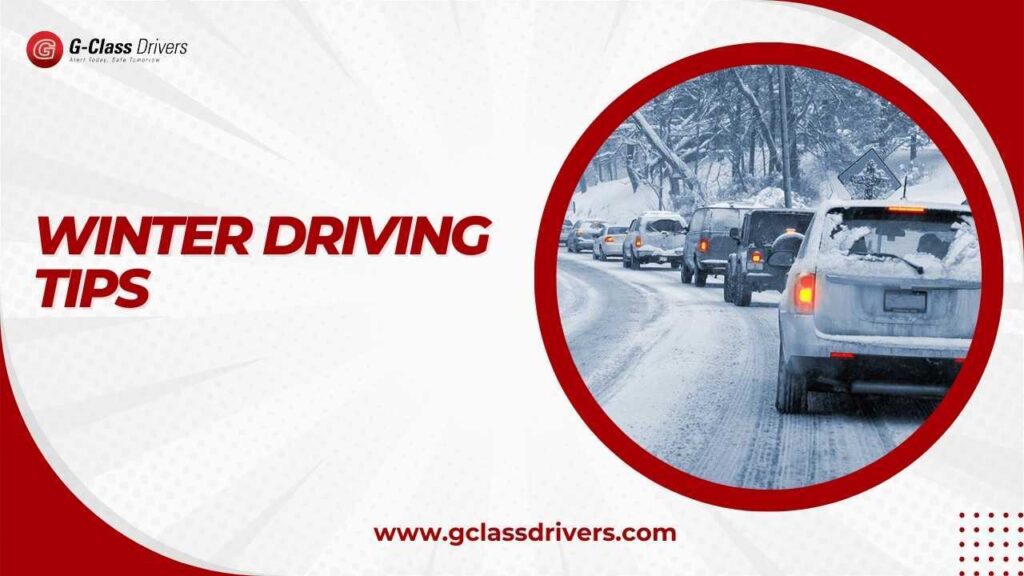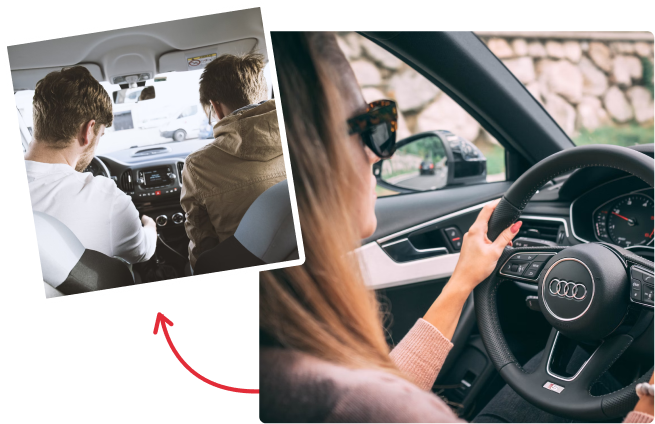Winter roads can be tricky, but with the right tips, you can stay safe and confident while driving. Don’t let snow and ice surprise you! Learn how to prepare your car and adjust your driving for the cold weather. Our easy tips will help you stay in control all season. Ready to make this winter your safest one yet? Let’s get started!
Winter Driving Tips for Different Conditions
Here’s a detailed breakdown of winter driving techniques based on different conditions:
1. Driving on Icy Roads
Slow Acceleration and Deceleration: On icy roads, it’s critical to accelerate and decelerate slowly. Sudden movements, like quick starts or stops, can cause your wheels to lose traction. Apply the gas gradually to prevent wheel spin. Similarly, avoid slamming on the brakes. Gently ease off the gas and apply the brakes slowly.
Increase Following Distance: Ice significantly increases stopping distances. A safe following distance in normal conditions is not enough. Leave 5 to 6 seconds between your vehicle and the one ahead. This gives you extra time to react.
Avoid Sudden Stops: Coming to a complete stop on icy roads can make it difficult to get moving again, as you may lose traction. Try to slow down enough to keep rolling without coming to a full stop when possible.
Winter tires: Switch to winter tires because they are specifically designed to handle snow, slush, and ice. They provide a better grip and reduce the chances of slipping. Ensure your tires have deep treads (at least 3.5 mm) for better traction.
2. Driving in Snow
Drive Slowly: Snow-covered roads reduce traction, making everything accelerating, stopping, and turning to take longer. Reduce your speed to improve control over your vehicle and give yourself more time to react.
Know Your Brakes: When driving in snow, it’s crucial to understand how your brakes work. For vehicles with anti-lock brakes (ABS), apply steady pressure to the brake pedal. For non-ABS vehicles, gently pump the brakes to avoid locking the wheels.
Avoid Powering Up Hills: Using too much power when climbing a hill can cause your wheels to spin. Build momentum on flat ground before reaching the hill, and use that to carry you up. Don’t accelerate too much while climbing.
Stay in Motion on Hills: Stopping while driving uphill in snow can lead to loss of traction. Maintain a steady speed without stopping until you reach the top of the hill.
Emergency kit: Winter conditions can sometimes lead to getting stuck or stranded. An emergency kit includes items such as a blanket, first aid supplies, a flashlight, non-perishable food, water, and jumper cables. A shovel can help if you get stuck in snow.
Longer stopping time: Snow and ice can dramatically increase your stopping time. Maintaining a gap of 8 to 10 seconds gives you more time to react if the car in front stops suddenly.
Battery check: The cold can significantly reduce your battery’s efficiency. If your battery is old, get it tested before the winter season begins. Consider replacing it if necessary, to avoid being stranded in freezing conditions.
3. Driving in Slush or Wet Conditions
Be Aware of Hydroplaning: Slushy and wet roads can lead to hydroplaning, where the tires lose contact with the road due to a layer of water. Drive slower than usual, especially in puddles or slushy areas. Reduce speed gradually if you feel the car start to lose grip.
Go Slower: Ice, snow, and slush reduce traction, making it easier to lose control if you’re driving too fast. Always reduce your speed based on road conditions. Even if the speed limit is 60 km/h, going slower might be necessary.
Increased stopping distance: On dry roads, you may need a few seconds to stop, but on icy roads, stopping can take much longer. Reducing your speed gives you more control and reduces the stopping distance, which is crucial in preventing accidents.
Use Signals Early: Let other drivers know your intentions early when roads are wet or slushy. Sign well in advance before turning or changing lanes to give others plenty of warning.
4. Driving in Fog or Limited Visibility
Visibility issues: Winter storms and fog can reduce visibility. By staying further behind, you allow yourself more reaction time if something unexpected happens.
Reduce Speed: Fog greatly reduces visibility, making it harder to see hazards ahead. Even if roads are clear, it’s important to slow down. Drive slowly and use low beams instead of high beams, as the latter can reflect off the fog and reduce visibility further.
Stay Alert: Fog can obscure not just other vehicles but also pedestrians and wildlife. Continuously scan the road and be ready to stop or swerve if needed.
5. Driving in High Winds
Hold the Steering Wheel Firmly: High winds can push your vehicle to the side, especially if you’re driving an SUV or truck. Keep both hands on the steering wheel to maintain control.
Watch for Wind Gusts: Sudden gusts of wind can push your car unexpectedly. Be cautious, especially when passing large vehicles that might shield you from the wind and then suddenly expose you to it.
6. Driving on Black Ice
Stay Calm and Avoid Sudden Movements: Black ice can be especially dangerous because it’s nearly invisible. Sudden steering or braking can cause loss of control. Keep your movements gradual slow acceleration, gentle braking, and smooth steering.
Look for Shiny Patches: Black ice often looks like a shiny section of road. If you suspect black ice, reduce your speed and avoid any sudden maneuvers.
Fluids: Keep your windshield washer fluid topped up with a formula designed for winter. Normal fluid can freeze, rendering your windshield wipers useless. Also, check that your antifreeze is at the correct level to prevent your engine from freezing.
7. Driving in Mixed Winter Conditions
Adapt to Changing Road Surfaces: In winter, you may encounter a mix of conditions ice patches, snow, slush, and wet roads all in a single trip. Always adjust your speed based on the current condition and watch for transitions between different surfaces.
Keep an Eye on the Temperature: Pay attention to outside temperatures, as roads can freeze at night or early in the morning, even if they appear wet. If temperatures drop below freezing, assume that wet roads might have icy patches.
Know alternate routes: If your usual route is prone to closures or becomes dangerous in bad weather, have alternate routes planned. Highways and main roads are often cleared first, so avoid smaller, less-traveled roads.
8. Driving During Winter Storms
Check weather reports: Always check weather forecasts and road conditions before starting your trip. Avoid driving during heavy snow or ice storms whenever possible.
Stay Home if Possible: The best safety measure in a severe winter storm is to avoid driving. If the weather forecast predicts a storm, it’s safer to stay home until conditions improve.
Prepare Your Vehicle: If you must drive during a storm, ensure your car is winter-ready with snow tires, working windshield wipers, and an emergency kit. Equip your vehicle with essentials like blankets, food, water, and a first-aid kit, in case you get stranded.
These techniques help drivers navigate various winter conditions safely. By adjusting your driving style based on the road and weather, you can stay in control and minimize the risks associated with winter driving.
Defensive Driving Techniques for Winter
Defensive driving is even more critical during winter. Here are a few defensive driving strategies you can adopt:
- Stay alert: Winter weather can be unpredictable. Stay focused on the road and keep an eye on other drivers.
- Avoid distractions: Do not use your phone, eat, or adjust the radio while driving in difficult conditions. Staying focused is key to reacting quickly.
- Expect the unexpected: Always anticipate potential hazards. Other drivers may make sudden moves, and black ice or snow drifts can appear without warning.
Enroll in a Winter Driving Course
Even with all these tips, there’s no substitute for proper training. At G Class Drivers, we offer winter driving courses designed to help drivers handle icy and snowy conditions with confidence. Our experienced instructors will teach you essential winter driving techniques, giving you the skills needed to stay safe on the road.
FAQs
What are the safety tips for winter?
Prepare your car with winter tires, check fluids, keep your gas tank full, and clear snow from your car. Drive slowly, brake gently, and increase the following distance.
What is the safest vehicle for winter driving?
Vehicles with all-wheel drive (AWD) or four-wheel drive (4WD), along with anti-lock brakes and good ground clearance, are safest for winter driving.
What drive is bad for snow?
Rear-wheel drive (RWD) is generally bad for snow as it provides less traction and can make it harder to control the vehicle on icy or slippery roads.
What is the safest speed to drive in snow?
Reduce your speed significantly, ideally 10-15 mph below the posted limit, depending on road conditions, and maintain a speed where you can control the vehicle safely.
What is the fear of driving in the snow?
The fear of driving in snow is called chionophobia, an anxiety or intense fear of snowy conditions or losing control on icy roads.
What is the most difficult driving season?
Winter is often considered the most difficult driving season due to snow, ice, and reduced visibility.





